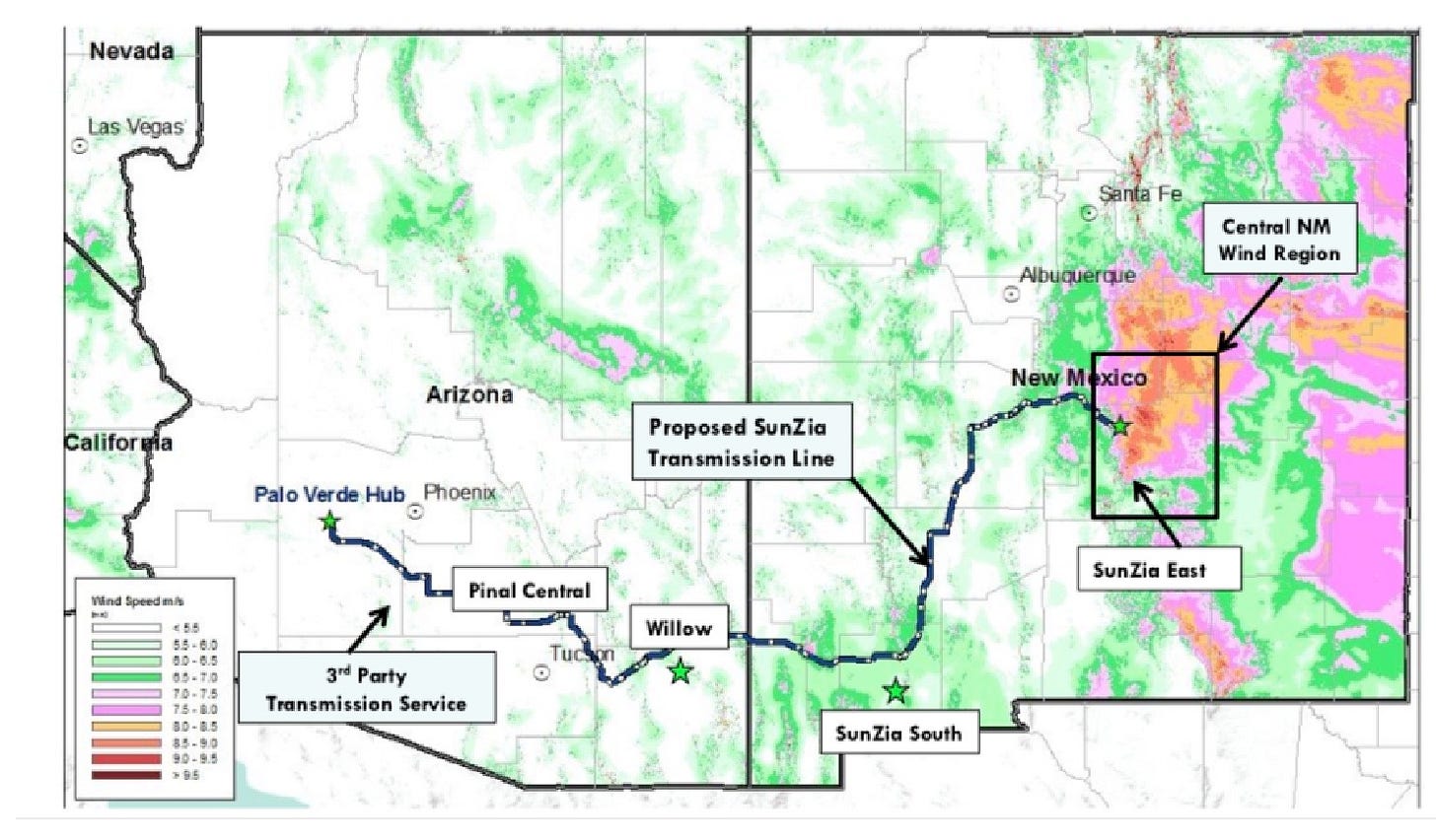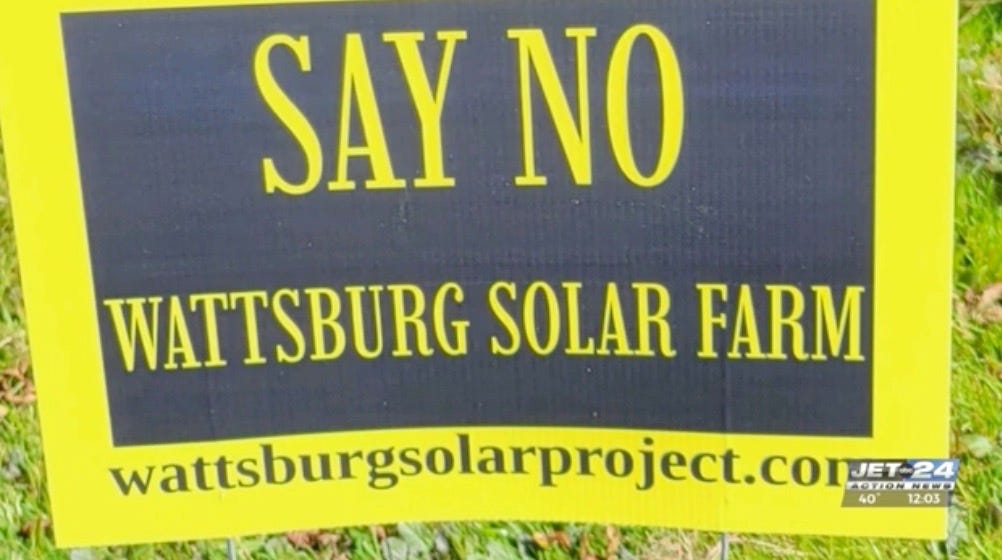Trailer For Juice: Power, Politics, & The Grid, Venango Spikes Solar, Tribes Sue To Stop SunZia, China Digs Coal
Our docuseries will be out next Wednesday, more rural resistance to solar, Apache and Tohono O’odham sue to stop SunZia, and China's record coal production
January has been a blur. I was in Tulsa, Denver, Houston, and Wimberley over a one-week span earlier this month. I was in San Antonio for a speaking engagement on Monday and Tuesday. I flew to Bismarck on Tuesday night for speeches on Wednesday and later today at the Energy Progress & Innovation Conference. (By the way, it’s not that cold here in Bismarck. Today, we had beautiful blue skies.) All month, I’ve been writing, preparing for my speeches, recording podcasts, and teeing up the release of our new docuseries, Juice: Power, Politics, & The Grid.
The five-episode docuseries will be published next Wednesday, for free, on YouTube. My colleague, Tyson Culver, has done a great job putting it all together. The series has original animations, an original score, and more than 30 interviews with some of the world’s top thinkers about energy and power. I’ll write more about it next week, but for now, have a look at the trailer:
Venango Supervisors Unanimously Reject 80-MW Solar Project
The backlash in rural America against alt-energy continues. The first rejection of 2024 occurred in Venango Township, Pennsylvania. On January 9, the Board of Supervisors in the township, which has a population of about 2,200, unanimously voted to reject a proposed solar project. Here’s how Matt Mathis of OurErie.com reported the story:
Many Venango Township residents are breathing a sigh of relief after supervisors unanimously rejected a proposed project they feared would redefine their community. That project was a 900-acre, 80 megawatt solar farm that would include about 300,000 solar panels in Wattsburg. “I’ve heard it referred to as a six-month nightmare, but we needed that time for them to become educated about the process and to come together as a community. Ultimately, we got the outcome that we wanted,” said Bruce Whitehair, Venango Township resident. Throughout those six months, township supervisors have known where the community has stood. Around 300 signs saying “no solar farm” were put up throughout the township by taxpayers.
Mathis also quoted Whitehair as saying, “Our township followed its comprehensive plan, its solar ordinance plan, its zoning handbook, to a ‘T,’ and we had outstanding community support against it and we had a unanimous vote from our supervisors.”
The Venango Township rejection of the Wattsburg project is the 195th rejection or restriction of solar energy in the U.S. since 2017. As always, full details can be found in the Renewable Rejection Database.
San Carlos Apache and Tohono O’odham Sue To Stop SunZia Line

The Osage tribe’s massive win over Enel last month in federal court is a landmark ruling. But other tribes are also suing to stop the landscape-destroying energy sprawl that comes with alt-energy and the over-hyped “energy transition.” While the Osage are looking forward to the ejectment of 84 wind turbines that Enel built by illegally mining in the tribe’s mineral estate, the San Carlos Apache tribe, Tohono O’odham Nation, the Center for Biological Diversity, and a Tucson-based non-profit called Archelogy Southwest, have sued to stop construction of a $10 billion high-voltage transmission project that aims to connect a wind project in New Mexico to consumers in southern Arizona.
On January 17, the groups filed suit in federal court alleging that the U.S. Bureau of Land Management failed to comply with federal statutes when it approved the 500-kV SunZia Southwest Transmission Project. The 32-page complaint alleges the project will cause “serious, irreversible adverse effects on Tribal cultural sites and sacred areas, including areas with human remains.” They are seeking a restraining order or injunction to stop the project and require federal agencies to adhere to the provisions of the National Historic Preservation Act and Administrative Procedures Act.
The lawsuit is the latest salvo in the long-running battle over the 520-mile-long project, which has been in development since 2015. Work on the transmission project was stopped for several days last November after the tribes protested but was resumed in what Tohono O’odham Chairman Verlon M. Jose called “a punch to the gut.”
The SunZia project was supposed to be a major achievement for the Biden Administration. On September 1, the Interior Department issued a press release that claimed the transmission line “advances the President’s historic clean energy agenda — a key component of Bidenomics.” It claimed the groundbreaking ceremony for the project in Corona, New Mexico, attended by Interior Secretary Deb Haaland and Biden advisor John Podesta, “is the latest example of how the Biden-Harris administration is advancing collaborative and efficient permitting of transmission lines and renewable energy projects on our nation’s public lands. This permitting progress will help achieve the goal of a carbon pollution-free power sector by 2035.”
On January 22, Archeology Southwest said the federal government and BLM are prioritizing “profit-driven interests” over the concerns of the tribes. It then quotes Jose as saying the tribes will “Use all lawful means to oppose this reckless powerline.”
The new litigation shows, yet again, that land-use policy and energy policy are inextricably linked. It also shows that the myriad claims that the U.S. can quickly transition to alt-energy — or, as the Interior Department claimed in its September 1 press release that the U.S. will have a carbon-free power sector by 2035 — is nothing more than hype.
Chinese Coal Output Sets New Record
Billionaire and former New York City mayor Michael Bloomberg and his myriad allies in the NGO-corporate-industrial-climate complex want to shut down coal plants. Given that predilection, they might consider looking at what’s happening in China. On January 18, Caixin Global reported:
China’s coal output hit a record high last year, as the country ramped up production to ensure energy security and avoid a repeat of crippling shortages in the preceding years. Coal production reached 4.66 billion tons in 2023, a 2.9% increase year-on-year, according to data from the National Bureau of Statistics. It also marks the third consecutive year that annual output has surpassed 4 billion tons. Despite ambitious long-term climate goals that include peaking carbon emissions by 2030 and becoming carbon neutral by 2060, as well as the rapid development of renewables, coal is still the mainstay fuel to safeguard China’s energy supply.
This report should not surprise anyone. As I noted here on December 12, in “COP28 Gets Coal In Its Stocking,” China’s coal-fired capacity has soared over the past few years, and a massive amount of new coal-fired capacity has been permitted or is under construction. I wrote:
On November 27, three days before the opening of the meeting in Dubai, Global Energy Monitor released a report showing that some 204,000 megawatts of new coal-fired capacity is now under construction around the world. Of that 204,000 MW, about 67% is in China. To put that massive amount of new capacity in perspective, the U.S. currently operates about 205,000 MW of coal-fired power plants. (The generating capacity of the entire U.S. grid is about 1.3 terawatts, or 1.3 million MW.) In addition to the huge amount now being built, another 353,000 MW of coal-fired capacity has been announced, pre-permitted, or permitted. Of that 353,000 MW in the queue, about 72% is in China.
Thus, the report from Caixin Global shows, yet again, that while the U.S. is spending hundreds of billions of dollars subsidizing EVs, wind, solar, and other boondoggles in the name of climate change, China is going to continue doing what is in the interest of China. The report also shows that China’s insatiable appetite for coal is helping fuel the ongoing rise in global CO2 emissions, which rose about 1.1% last year to a record 36.8 billion tons.
Please click that ♡ button, share, and subscribe.
Please share the link to the trailer for the docuseries and while you’re on our film’s YouTube page, please hit the subscribe button.
Thanks.







The federal government has a bureaucracy devoted to developing "clean energy resources" on Indian reservations. We, naively, bid on a couple of studies, and got both contracts. On our first site visit, the two of us were joined by enough federal agency employees to fill two large passenger vans, which followed us around to a couple of possible sites and the tiny 60 Kv substation that was the only possible interconnection point. The government people would unload from the vans, walk around, talk and laugh, had no idea what they were looking at and had no interest in finding out.
We came back to meet with the tribal leaders. Us, four guys from the tribe and a standing room only crowd of government people. We talked about the day and next steps for the study.
The tribal "War Chief" pulled us into his office after the meeting and said... Every time white people show up around here we get screwed. They built a dam right on top of the sacred burial grounds, flooded our melon fields... etc... I don't care about the solar energy or whatever BS you are talking about, I want you to get the hell off our land and never come back. They made this guy the war chief for a reason.
We told the government that the interconnection was too expensive and challenging the project was not worth pursuing, which was true. We sent the report and never went back.
Trailer and Docuseries lookin good Robert. Keep up the nice work. Alarming how many $$$$Trillions are being taken from hardworking citizens and misspent on clearly misguided energy sources and "feel good" programs that are exploding our and the world's debt on less reliable, much less energy dense, and counterproductive energy initiatives. Jeopardizing the grids. Almost completely dependent on Communist China mining and refining for the resources and supply chains. Not good. Nearly lunacy in reality.